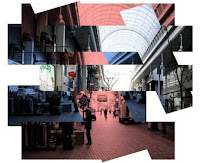No art is as inclusive as fine arts or call it whatever.
It seems every single person is born with artistic talent specifically more pronounce and visible in the field of fine arts, abstract art or call it whatever, an artist even in you, whether you consider yourself an artist or not that is irrelevant, proof is your childhood notebook filled with weird characters drawn by you and spoiled pages of your dad's diary and all the tattoo that you made on your hand, graffiti on your school desk and crayon spoiled walls of your house where you spent your childhood days and that creative surge when you were staring at the damp basement or loo walls trying to infer some meaning out of those grunge damp patterns, or even today if you occasionally tend to draw a smiley face on moist, dew clad surface and so on. Every adult was an artist in his or her childhood so they are today, so are you.
Every child with his or her genuine creativity, making and living their own dreams in their sketchbook or on wall, vivid and real in their own imagination, a spell-bounding piece of rawness with bit of influence from surrounding, and we are not talking about all the art and craft assignments forced by educational curriculum and competition, those are plastic, manipulated, and imposed, threatening and robbing the very creative rawness of child. We are not talking about biased aesthetic judgement here. We are talking here for example the child's own interpretation of how round a sun should be or how round his dexterity allows him to draw it, not the Vinchi style geometric perfectness of circle which we tend to impose on them. Since art being essentially a true expression of self does not necessarily demands shape of circle to be a perfect circle so it really doesn't matter how well you used to draw a circle to qualify as an artist in your childhood, and since art is beyond the clutch of time so if you draw the similar weird circle today when you are grown up it is still an art and so you are an artist. Another reason is that if making a perfect circle is a qualification criteria for an artist than our computer or tab can do that job better than our master artist.
So acknowledging the truth of your own childhood talent now you can appreciate the works of kids around better. Not judging them on their perfectness but admiring them for their innocence. You see these kids will grow up one day and change the very definition of understanding of what an art should be. After all its art if you can prove it.
You might also like to read this post on "design diplomacy"
You might also like to read this post on "design diplomacy"






